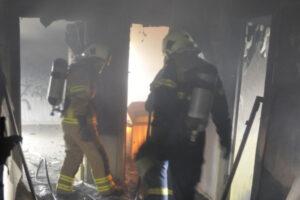Evaluating fire, smoke, soot, and water damage is the priority in determining what can be salvaged after a house fire. But your safety is most important.
Stay out of a fire-damaged structure until the fire department says it’s safe to return. Also, follow safety guidelines from the Red Cross and our ‘what to do after a house fire‘ checklist before returning to the property.
The Dangers of Soot and Smoke
Soot is a powder, while smoke is a vapor cloud. These tiny particles contain carbon, tar, oils, ash, and a multitude of other chemicals and fumes.
Smoke Odor Removal
 Smoke may seem harmless, but smoke inhalation (not burns) is the primary cause of fatality from indoor house fires.
Smoke may seem harmless, but smoke inhalation (not burns) is the primary cause of fatality from indoor house fires.
Smoke particles cause a range of health problems, according to the EPA, from burning eyes and a runny nose to aggravated chronic heart and lung diseases. Exposure to particle pollution is even linked to premature death.
So, though an item salvaged after a house fire may seem undamaged, the lingering chemicals and smoke smell may be hazardous.
Black Carbon Soot
 Black soot is an unwanted and often toxic byproduct of some combusted materials. Burned plastics, for instance, produce soot along with poisonous gases such as carbon monoxide and hydrogen chloride. Other chemical-containing products found in the household include foams, fabrics, carpets, wood, synthetic fabrics, wool, and asbestos-containing materials.
Black soot is an unwanted and often toxic byproduct of some combusted materials. Burned plastics, for instance, produce soot along with poisonous gases such as carbon monoxide and hydrogen chloride. Other chemical-containing products found in the household include foams, fabrics, carpets, wood, synthetic fabrics, wool, and asbestos-containing materials.
Soot contains dioxins. Often sticky, it coats everything with a layer of brown or black powder. Because of the miniscule size of the particulates, soot enters the lungs or bloodstream through inhalation. Exposure to soot can cause serious health concerns, such as aggravated asthma, bronchitis, heart attacks, cancer, and strokes.
Both soot and smoke damage are compelling reasons to get professional help before you decide on items salvaged after a house fire.
How to Restore Items Salvaged After a House Fire
During your contents assessment, we first want to prevent the spread or contamination of toxic soot. Burned items are removed from the property as soon as possible to reduce further soot and smoke pollution, mold damage, and to improve the indoor air quality.
Unburned textiles such as curtains, drapes, and clothing with smoke, soot, or water damage are often salvageable. Some water-damaged furniture can sometimes be restored. We may also be able to save smoke-damaged paper items such as important documents and photos.
Contents packout services protect and restore your sentimental and valuable personal property. We will sort, pack, clean, store, and return items that are salvaged after a house fire. Using a detailed inventory system to account for your possessions, we note where in your home each item was, and its condition after the fire.
Note that burned or melted plastic can’t be salvaged after a house fire.
What About Insurance?
It is essential to itemize every item that was damaged. We recommend taking pictures of your home’s contents, including the items that are being discarded. We will help you mitigate your insurance claim.
Take Steps to Prevent House Fires
Keep your family and your belongings safe by following some simple fire prevention tips.
- 6 ways to prevent electrical fires.
- Kitchen fire safety.
- Smart home devices.
- Get the best smoke alarms.
- Learn the most common home fire causes.
ATH, Your Phoenix Fire Damage Restoration Professionals
Begin the fire damage restoration process as soon as possible. Smoke odor and soot continue damaging your property and can cause serious health problems.
ATH provides 24/7 emergency service for homeowners and property management services. Contact us for a free onsite consultation to guide you in what can be salvaged after a house fire and begin the recovery process.
